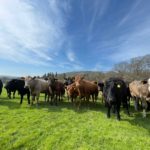This is the time of year when, at first light, a quite phenomenal ritual occurs on the highest and most remote parts of the Rhug Estate.

JOUSTING AT DAWN
Congregating in several small areas of moorland where the vegetation is not too high, contests takes place between male Black Grouse, known as ‘Blackcock’. These gatherings, called ‘leks’ can involve anything from a few to a few dozen birds.
The event is preceded by the birds inflating their necks to create a sound chamber for the production of a rhythmic, far-carrying bubbling sound, periodically punctuated by a somewhat angry-sounding ‘sneeze’. They also raise their tails to reveal striking white under-tail plumes which makes them stand out against the dark vegetation of the heather moor.
These males will square up to each other and look as if they are about to indulge in serious combat. However, this is rarely the case, the majority of the activity appearing to be bluff. Occasionally there seems to be more of a spat where they leap at each other but the worst damage is the loss of a small feather or two.
Rather oddly, the birds reach a point where they seem to have had enough and all fly off together to feed with no apparent trace of any hostility towards each other.
The purpose of this jousting event is believed to be an opportunity for males to demonstrate their prowess to a female which is hopefully watching and will, in turn, select the most impressive performer. The event goes ahead whether or not she is in attendance and such is the determination of the males to ensure they are seen I have encountered lone birds lekking, their aggressive thrusts being aimed at an imaginary opponent!
In order to see this spectacle at its peak it requires a very early start and each year teams of volunteers gather in April to do an annual count where numbers of lekking males from various sites are simultaneously counted, across the whole of the north Berwyn.
North Wales remains an important stronghold for the Black Grouse which has declined nationally and continued appropriate management of the moors will provide the best chance of the survival of this magnificent species.Back






Next
ABOUT THE AUTHOR
Keith Offord has been studying and monitoring bird populations on the Berwyn since 1974. All images and words © Keith Offord
HTTP://WWW.KEITHOFFORD.CO.UK/Visit Keith’s Website






 Organic Beef
Organic Beef